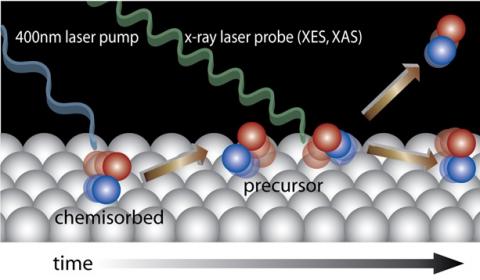
The adsorption and desorption of a molecule to a surface is one of the most fundamental chemical process in interfacial chemistry. It has been proposed that adsorption and desorption proceed through a “precursor” state (1,2), in which a molecule is weakly bound to the surface. This is considered a transient state, in which the rotational and translational energy of the molecule is transferred from the surface before forming and to the surface after breaking a chemisorption bond. Though a large number of spectroscopic studies have been devoted especially to CO adsorption/desorption on metal surfaces, this “precursor” state has never before been evidenced.
The occupied and unoccupied valence electronic structure of adsorbed CO molecules on surfaces can be followed in an atom-specific way using x-ray emission spectroscopy and x-ray absorption spectroscopy, respectively (3). At SSRL, scientists have developed a next-generation experimental setup for these studies. It is equipped with a high-throughput compact grazing incidence grating spectrometer developed by Dennis Nordlund, Hirohito Ogasawara and Anders Nilsson. The commissioning of setup and preparatory static measurements of the CO-Ru chemisorption bond for this study were performed at SSRL Beam Line 13-2 (4).
In this study, the setup was brought to the Linac Coherent Light Source to probe the short lived “precursor” state by the SSRL scientists, in collaboration with researchers from Stanford University; University of Hamburg, Center for Free-Electron Laser Science, Helmholtz-Zentrum Berlin for Materials and Energy, University of Potsdam and Fritz-Haber Institute of the Max Planck Society in Germany; Stockholm University in Sweden; and the Technical University of Denmark. They followed the electronic structure of CO molecules as their chemisorption state on Ru(0001) changed upon exciting the substrate with a femtosecond optical laser pulse. They observed electronic structure changes that are consistent with a weakening of the CO interaction with the substrate, but without significant desorption. A large fraction of the molecules (30%) were trapped in a transient precursor state that preceded desorption. The team calculated the free energy of the molecules as a function of the desorption reaction coordinate using density functional theory, including van der Waals interactions. Two distinct adsorption wells—chemisorbed and precursor state separated by an entropy barrier—explain the anomalously high prefactors often observed in desorption of molecules from metals.
1. P. Kisliuk, J. Phys. Chem. Solids 3, 95 (1957).
2. J. B. Taylor, I. Langmuir, Phys. Rev. 44, 423 (1933)
3. A. Nilsson, L. G. M. Pettersson, Surf. Sci. Rep. 55, 49 (2004)v
4. T. Katayama et al, J. Electron Spectrosc, in press (2013)
M. Dell'Angela, T. Anniyev, M. Beye, R. Coffee, A. Föhlisch, J. Gladh, T. Katayama, S. Kaya, O. Krupin, J. LaRue, A. Møgelhøj, D. Nordlund, J. K. Nørskov, H. Öberg, H. Ogasawara, H. Öström, L. G. M. Pettersson, W. F. Schlotter, J. A. Sellberg, F. Sorgenfrei, J. J. Turner, M. Wolf, W. Wurth and A. Nilsson, “Real-Time Observation of Surface Bond Breaking with an X-ray Laser”, Science 339, 1302 (2013)




